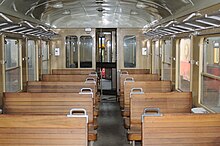M1 car
| M1 car | |
|---|---|
|
Museum-preserved M1 car in Saint-Ghislain
|
|
| Numbering: | 43001-43115 (AB) 42001-42214 (B) 49001-49118 (BDx) |
| Number: | 115 (AB) 214 (B) 118 (BDx) |
| Manufacturer: | Ateliers de la Dyle |
| Year of construction (s): | 1935-1937 |
| Retirement: | 1986 |
| Genre : | Passenger coaches |
| Gauge : | 1435 mm ( standard gauge ) |
| Length: | 22,756 mm |
| Height: | 3,776.5 mm |
| Width: | 2,950 mm |
| Trunnion Distance: | 15,956 mm |
| Bogie axle base: | 2,500 mm |
| Top speed: | 120 km / h |
| Wheel diameter: | 1,050 mm |
| Floor height: | 1,225 mm |
As M1 cars are coaches the NMBS / SNCB designated prepared 1935-1937. Three variants of the M1 car were in use: as a mixed-class car with first and second class M1 AB , as a purely second-class car, M1 B, and from 1966 as a second-class control car, M1 BDx .
history
In order to replace various wagons from the 19th century, the NMBS / SNCB put out an order for a larger number of passenger wagons in the early 1930s. The Ateliers de la Dyle from Leuven and the Ateliers Métallurgiques de Nivelles participated and each delivered three prototypes. The construction of the Ateliers de la Dyle was convincing; over 400 series cars were produced on its basis.
Numerous cars were destroyed in World War II; but most of the damaged wagons were rebuilt. Due to the German occupation, M1 cars also reached Germany and were later used by the Deutsche Reichsbahn in the Rbd Halle until the 1970s.
In 1966, the conversion of the M1 B car into a control car began. The first push-pull trains ran between Pepinster and Spa on August 1, 1966 . Three control cars were also given a third top light so that they could travel to France and Maastricht .
From 1980 onwards, the M1 cars were increasingly retired and replaced by M4 cars . The plan was to take all M1 cars out of service by the time the IC / IR plan was introduced in 1984. Above all, the control cars, which were compatible with M2 cars , were used until 1986, most recently between Mons and Geraardsbergen .
20 M1 cars have been preserved in a museum.
Furnishing
The body of the M1 carriages was made entirely of metal; the doors could be controlled pneumatically, a major step forward at that time . The comfort of the cars, on the other hand, was often criticized: In the second class there were only wooden benches, the windows were stiff, the soundproofing was insufficient and the suspension was hard. Nevertheless, the wagons were not modernized during the entire period of use in Belgium.
Web links
- Description of the M1 wagons on belrail.be (French)
- Technical data and construction sketch on belrail.be (French)
Individual evidence
- ↑ M1 B 42.005 on stoomcentrum.be (Dutch) , accessed on June 20, 2014.


